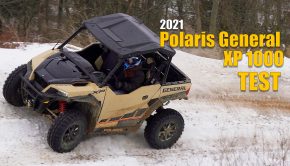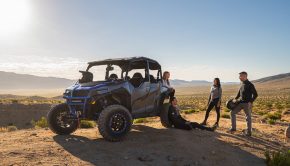Published on March 9th, 2024 | by Joe
2024 Kawasaki Ridge VS Ridge XR Test Review: Which is best for You?
From the numerous teaser videos online to the mullet filled Super Bowl commercial, the brand new Kawasaki Ridge received one of the most highly promoted and anticipated SXS roll-outs of all time, in an effort to recruit new SXS enthusiasts.
Kawasaki markets the Ridge as a sport/utility machine, making it a competitor with the Can-Am Commander, Polaris General XP, and Yamaha RMAX 1000. Examining the Ridge’ specifications, with unique features like the only inline 4 cylinder engine in the class, it appears that Kawasaki is intent on delivering serious sport/utility performance. Although, with the ability to tow 1 ¼ tons, haul a half-ton in the bed, and options like two or three-seat capacities, automotive-inspired, fully enclosed, climate controlled cabins on certain models, the Ridge is designed to deliver work capability and options once reserved for the rec/utility segment, featuring machines like the Polaris Ranger and Can-Am Defender. Already blurring boundaries, the Ridge and Ridge XR models offer some distinctly different features, providing a slightly different experience for different types of drivers. Confused yet? Make sure to watch till the end. By then, we’ll tell you everything you need to know to pick which Kawasaki Ridge for your needs.
To prove the Ridge was really worth the hype, Kawasaki invited members of the media to the Hatfield McCoy Trail System in West Virginia to put the Ridge to the test. The Appellation Outpost in Charleston, West Virginia offers a bunch of brand new cabins, the Broken Axle restaurant and bar, conference center, gas station on site, and immediate access to the Rock House trail. The incredible hospitality, convenience, and overall experience make the Appalachian Outpost a place we thoroughly enjoyed staying at. We’d recommend it to other manufacturers for events and for anyone looking to enjoy themselves riding at the Hatfield McCoy Trails.
Trim Packages
The Ridge and Ridge XR are offered in various trim packages. Utilizing the same engine as the Ridge, the Ridge XR models take a jump in horsepower from 92 to 116. Drive modes are different with all Ridge featuring a limited slip rear differential in 2wd. The limited slip front differential kicks in in 4WD and the rear differential locks in 4WD lock. The XR models differ by fully locking both the front and rear differentials in 4WD lock. XR model tires increase in diameter from 27” to 30”, increasing ground clearance. Most XR models feature dual high-backed bucket seats replacing the 3-seat bench seat found in the standard Ridge. XR models also gain front LED accent lights.
The Ridge is available in four trim packages. Available as a 2025 model, there’s the base model with pricing to be announced. The 2024 Ranch Edition picks up a Warn VRX 45 winch and unique look for $23,999. The fully enclosed, climate controlled HVAC model features automotive glass all around with a washer and wiper equipped windshield; a lined, dome light equipped roof; rear view mirror; and sells for $29,999. The premium enclosed and climate controlled Ridge Limited, one of the models we’re testing, gains a WARN VRX 45 winch, 8-in touchscreen infotainment system with a Garmin GPS and group ride , four-speaker stereo, front and rear facing cameras, and a painted rear bumper listing for $33,499.
116hp XR models include the standard Ridge XR. The XR Deluxe is the one XR model featuring a 3-passenger, bench seat with adjustable driver’s seat. The Ridge XR HVAC, the other model we’re testing, has a fully enclosed, climate controlled cabin with automotive glass, and a washer and wiper equipped windshield, lined roof with dome light, and a rear view mirror.
In our opinion, pricing is competitive across the line when compared to equivalent machines from either the rec/utility or sport/utility segment.
Engine Design
A brand new engine was developed for the Ridge with a focus on minimizing noise and vibration and maximizing performance. The result is a 999cc, inline 4-cylinder, water-cooled engine with four valves and double-overhead-cams per cylinder. With a sporty 10.6:1 compression ratio, fuel is delivered to the engine via EFI. A 12.9 gallon fuel tank is class leading.
Both models feature three throttle modes: work, normal, and sport for different vehicle applications, types of terrain, or your mood and driving style. . Thanks to unique ECU tuning and different exhaust, Ridge XR models produce 116 HP and 73.8 lb-ft of torque with non XR models producing 92 HP and 65.8 lb-ft of torque. We frown on manufacturers using the exact same engine with different tunes to reach different horsepower levels and price points, and, unfortunately, it’s becoming more common. Other machines in the sport/utility class produce between 100 and 108 HP. Similar displacement rec/utility machines are claiming 82 HP.
Air is drawn from high under the hood with the final intakes mounted at the front of the engine with air filter access available from inside the cab. A rear exiting exhaust and fan cooled engine compartment help mitigate noise and heat.
Drive duties begin with a fully-automatic CVT transmission featuring high and low forward ranges, plus neutral and reverse. XR models feature stiffer clutch speeds for faster engagement at a slightly higher RPM for snappier acceleration. Without a centrifugal clutch, engine braking is provided electronically by slightly opening the throttle on descents with zero throttle input to keep the transmission engaged while providing engine braking under deceleration.
Both Ridge models feature two-wheel-drive, four-wheel-drive, and four-wheel lock settings. In two wheel drive, both Ridge models operate with a limited slip rear differential, similar to turf mode on other models, to minimize damage to sensitive surfaces. In four-wheel drive, the limited slip front differential kicks in. In four-wheel lock, the Ridge’s rear differential fully locks. In the XR, both the front and rear differentials lock.
Like others, Kawasaki boasts of a rather infrequent maintenance schedule for air filter servicing and oil changes, and maintenance access points are easy to get to. We’d continue servicing air filters and changing oil frequently to maximize its lifespan.
Chassis and Suspension
Known for their robust build quality, Kawasaki developed a brand new tubular steel chassis for the Ridge. The ROPS is profiled, allowing flush mounting of the windshield, doors, and rear panel. Plastic skid plates protect the underside of the frame. Steel wheel wells are used up front to protect the occupants from debris that can punch through plastic into the cab, a safety feature that should be found on all SXSs.
Double wishbone suspension is used at both ends delivering 12.7” of wheel travel, which is pretty competitive in the sport/utility class. Kawasaki boldly decided to forego sway bars at both ends to maximize articulation. Shock spec seemed more in line with the rec/utility than the sport/utility segment. Five-way preload adjustable shocks are used at all four corners, unlike the threaded preload, nitrogen reservoir and damping adjustable shocks found on current high-end, sport/utility models. Rack and pinion steering with speed sensitive electric power steering is standard on all models.
Both Ridge and Ridge XR models utilize 14” cast aluminum wheels, wrapped in Duro Power Grip II tires. The Ridge rolls on a staggered tire setup with 27×9-14” fronts and 27×11-14” tires rear resulting in 12.6” of ground clearance. Tire load ratings dictated the use of the staggered setup in order to provide the same load and towing ratings across both units. The XR scores 30” tires and a square tire setup, rolling on 30×10-14” tires at all four corners. We typically prefer the handling characteristics of a square tire setup, and it allows you to swap front and rear wheels more easily in the event of a front flat. The XR’s taller tires yield a very competitive 13.8” of ground clearance.
The Ridge measures in at 64” in width with a 90.7” wheelbase and a 125.4” overall length. Overall height is 82.3” for the XR and 81.1” for the standard Ridge. Overall, they’re a little larger than most of the machines in the class. A curb weight of 1,898.5 pounds for the non-cab equipped Ridge XR is in line with other sport utility SXS. The XR HVAC weighs 2,066.1 pounds with the Ridge Limited at 2127.8 pounds, putting them in line with the weight of the other enclosed, HVAC equipped rec/utility SXSs.
Brakes
Four-wheel, hydraulic disc brakes slow the Ridge. 249mm rotors are used at all-four corners. Front to rear braking bias is achieved by using dual-piston calipers used up front and single-piston calipers used outback. Ridge models are parking brake equipped.
Work Capability
While current sport/utility machines seem to trade a bit of utility capability for improved sport performance, the Ridge doesn’t seem to. Rated to tow 2,500 pounds with its two-inch receiver, in addition to hauling another 1,000 pounds in the bed, weight capacities are in line with the rec/utility segment. Cargo bed dimensions are also much closer to what we’d expect to find on a rec/utility than a sport/utility machine. Operation is standard for the industry. It’s hydraulically assisted and opens with an easy-to-use lever on either side of the bed.
Both models feature floor space under the passenger seat. On bench seat equipped models, the passenger seats flip providing even more room. Both also feature some behind the seat storage on either side.
Interior and Other Details
The Ridge features well laid out, automotive inspired interiors with interior lighting and backlit switches on all models. The column of the 24.4° tilt adjustable, D shaped steering wheel is covered for a clean look. Two-seat models feature slide adjustable driver and passenger seats with 5” of movement in ½” increments. Only the driver’s seat is adjustable on 3-passenger models.
The center backrest flips down on 3-seat models providing two additional cup holders and a couple added storage trays. Two-seat models feature a storage box under the center armrest. Added in cab storage is provided by the right side mounted glove box. There’s a small flip top box on the top right with dual USB ports. All non-HVAC models have a top, center dash mounted storage box, and all models, except the touchscreen equipped Limited, have a nice sized storage pocket center dash. Limited models gain an upper storage box located above the windshield between the speakers. Six cup holders are also found in all units.
All HVAC equipped models feature a fully enclosed cab with a fixed windshield and glass used on all four sides. Windshields are sprayer and wiper equipped. Door windows are powered on all models.
That’s enough of the details, now, let’s get to the test.
The Test
Hitting the Bearwallow Trail with the Ridge Limited in the Morning, then the Rockhouse Trail in the afternoon with the Ridge XR HVAC, we put a little over 50 miles on the Ridge on relatively easy trails. Switchbacks, water breaks and a few moderate rocky hills posted the biggest challenges.
The Ridge greets you with high sided, high-quality rubber sealed doors that close tightly. The Ridge is easy to get into and out of with plenty of floor space. The bench seat on the Ridge makes getting in and out a bit easier. Switches, latches and handles all seemed high quality. About the only thing that screamed utility to us was the pull out parking brake handle, and we honestly don’t have an issue with it.
The seats are comfortable on both units, although we give the nod to the slightly thicker, more bolstered seats on the XR. They’re thicker on the base of the front giving them a slightly more laid back feeling. They also raise the occupants a bit, enhancing the sight line out of the front.
That being said, the sight lines are excellent out the rear, sides, and front of the unit. The short, steep hood seems to disappear in front of you, excellent for rock crawling, steep descents, or operating with the Ridge in a tight space.
Hitting the trail in the morning, the Temps were in the lower 40s, but we were warm and toasty inside the Limited. Power output on the 92 HP ridge was strong and satisfying. Low end power is decent. We’re not sure it will growl around quite as happily at super low RPMS as a twin cylinder, but it more than makes up for it as the RPMs climb a little. Midrange and top-end are good, and it seems that the engine and CVT are tuned to do their best work in the midrange and up. At first, it had us wondering how quickly the engine was going to top out, but we managed to get the Ridge up into the 60s and climbing before we ran out of trail. The Ridge is claimed to top out at 68 with the Ridge XR topping out at 74 MPH. In cabin noise throw-out was low enough that we were communicating without much effort while wearing helmets.
Engine braking worked reasonably well, especially in low range, although we aren’t sure it delivers the same consistent feel we’ve come to expect from a centrifugal clutch equipped transmission.
Switching to the Ridge XR in the afternoon, the sun had come out and we wound up running the air conditioning. And who cared what the ambient temperature was; we enjoyed consistent comfort. Hitting the gas, the added punch of the stiffer clutch springs and 116 horsepower output were immediately detectable taking the sport feeling of the Ridge XR to a higher level. It wasn’t enough to make us turn our nose up at the Ridge, but it certainly delivered more fun factor.
The stiffer springs improve off idle acceleration. Power seemed to improve throughout the RPM range. The XR still prefers to rev, and it delivers more excitement when you let the inline-four rip.
With its horsepower increase assisted by a freer flowing exhaust tip, along with it comes a bit more noise, forcing you to up your conversation volume a little. We asked around, and everyone was in agreement that the XR is a bit louder.
With a limited slip rear differential until you implement four-wheel lock, the drive modes on the Ridge and Ridge XR aren’t intuitive if you’ve been driving ATVs and SXSs for years, but once you sort it out, the drive system worked well. The limited slip rear differential in two-wheel drive was all we really ever needed during testing, swapping to four-wheel drive to engage the limited slip front differential to help pull us through turns and up a couple questionable sections. Four-wheel lock was completely unnecessary for our testing, although the XR’s locking differentials front and rear would have the biggest advantage in the gnarliest terrain. The four-wheel lock mode on the ridge with its locking rear differential and limited slip front differential would be most advantageous racing out of corners on fast trails. We kind of wish they would have simply put the rear differential on its own switch, but we’re being picky.
While the shock spec appears utilitarian, its ride quality is worthy of the sport utility class. Small bump compliance invites all-day rides with good mid-stroke support and bottom resistance. Switching from the 27” tire-equipped Ridge to the 30” tire-equipped XR, the difference in ride quality was small, further emphasizing the quality of Kawasaki’s shock tune. The suspension ate a number of decent hits without a hint of bottoming. We managed to bottom both ends once, jumping off a water break into a slight dip, so we know bottoming the shocks is possible, but you’re going to have to push pretty hard to find their limits.
The lack of sway bars aid in articulation and small bump compliance without a serious detriment in handling. The Ridge handles relatively flat whether you’re accelerating, braking, or cornering. Admittedly, we didn’t get the opportunity to really push hard. Even still, the Ridge lacks the boaty feeling we’ve experienced in rec/utility SXSs. Handling is more sport/utility than rec/utility. Steering on all Ridge models is light and precise with little bump feedback.
Braking performance is very good. There’s plenty of power, and braking balance was well dialed. Good feel through the pedal made the brakes easy to modulate with no unwanted lock-ups.
While we didn’t get to test the Ridge’s utility capabilities, Kawasaki certainly has a reputation for building hard working vehicles with their Mule line. With capacity ratings that rate in the rec/utility category, the Ridge could easily be the hardest working machine in the sport/utility segment.
Conclusion
After driving the Ridge, it’s pretty clear what Kawasaki was going after–- sportier than a rec/utility machine, with greater utility capability and creature comforts than the sport/utility class. A true crossover, the Ridge could compete in either class.
So how do the Ridge and Ridge XR compare? The Ridge rewards you with a quieter experience than the Ridge XR while still delivering 10 HP more than its two main rec/utility rivals. Of course, if you want to enjoy factory installed GPS and stereo, the Ridge Limited is your machine. Perhaps the Ridge leans slightly toward the rec/utility category compared to the XR, but its ride is just as sporty with engine performance that isn’t lacking in terms of capability on the trail.
The more sport/utility class focused Ridge XR definitely ups the fun factor with its added horsepower and snappier clutching. The chassis didn’t seem at all taxed by the extra performance. The larger tires didn’t seem to hamper engine or handling, leaving us feeling the Ridge was developed around the higher horsepower and larger tires of the XR. With 8 HP more than the current sport/utility class leader, the Ridge XR is built to party as hard as it works.
The Ridge and Ridge XR are different, unique, and for many, they’re a SXS without compromise.
For more information on the Kawasaki Ridge and their full line of SXSs and ATVs visit Kawasaki.com










